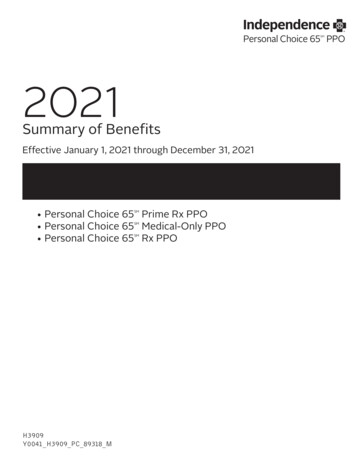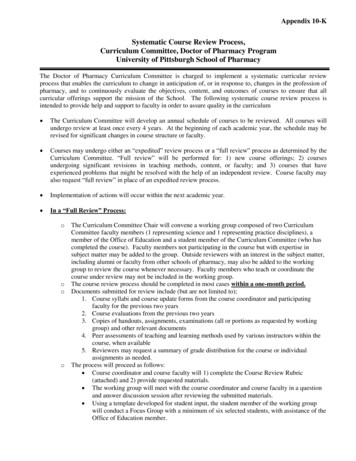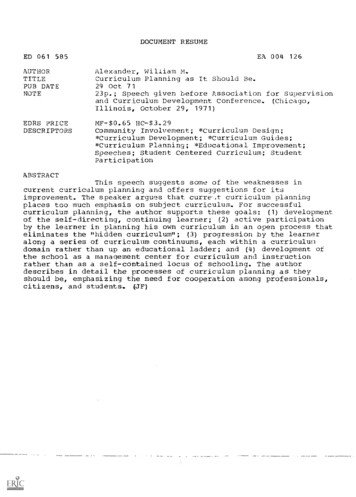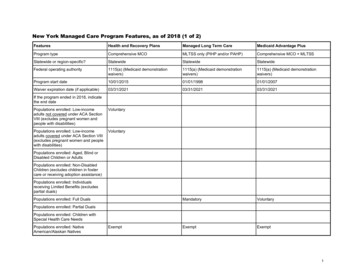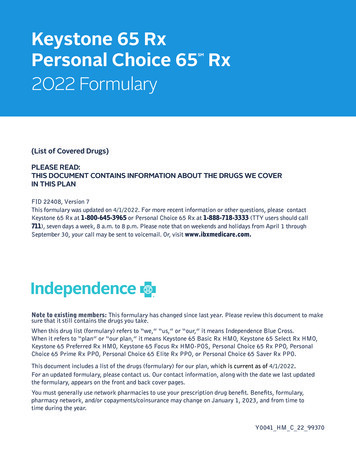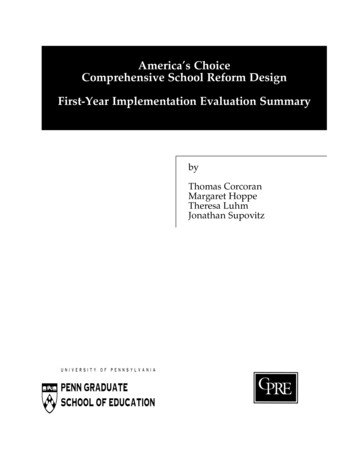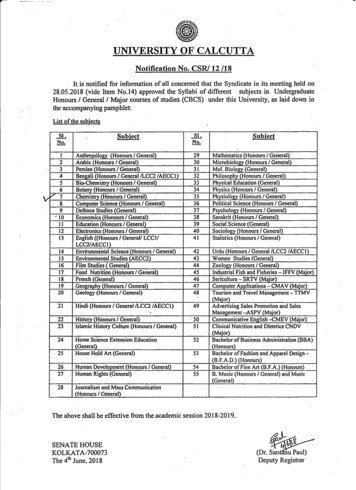
Transcription
COURSE CURRICULUM UNDER CHOICEBASED CREDIT SYSTEMSYLLABUSFORBACHELORIN CHEMISTRY (HONOURS)UNIVERSITY OF CALCUTTA1
Course StructureCourse CreditsTheory Practical Core Course (CC)Theory (14 Papers of 4 credits each)14 4 56Practical (14 Papers of 2 credits each)14 2 28Discipline Specific ElectiveCourse*(DSE)Theory (4 Papers of 4 credits each)Practical(4 Papers of 2 credits each)4 4 164 2 8Generic Elective (GE)Theory (4 Papers of 4 credits each )Practical(4 Papers of 2 credits each)4 4 164 2 8Ability Enhancement CompulsoryCourse (AECC)(2 Papers of 2 credits each)Environmental ScienceEnglish/MIL Communication2.SkillEnhancement Elective Course(SEC)(2 Papers of 2 credits each)2 2 42 2 4Total credit140*Optional Dissertation or project work in place of onethDiscipline Specific Elective paper (6 credits) in 6 Semester2
CORE COURSES FOR B. SC. HONOURS (CHEMISTRY)SEM1CODE*PAPERBRIEF DESCRIPTIONCEMA-CC-1-1-THAcid-base and redox reactionsBasics of Organic ORGANIC CHEMISTRY-1ORGANIC CHEMISTRY -1APRACTICALS**PHYSICAL CHEMISTRY-1ORGANIC CHEMISTRY -1BPRACTICALSORGANIC CHEMISTRY -2PRACTICALSINORGANIC CHEMISTRY-2PRACTICALSPHYSICAL CHEMISTRY-2PRACTICALSINORGANIC CHEMISTRY-3PRACTICALSORGANIC CHEMISTRY -3PRACTICALSORGANIC CHEMISTRY - 4PRACTICALSPHYSICAL CHEMISTRY- 3CEMA-CC-4-9-PCEMA-CC-4-10-THPRACTICALSINORGANIC PHYSICAL CHEMISTRY -4CEMA-CC-5-11-PCEMA-CC-5-12-THPRACTICALSORGANIC CHEMISTRY -5CEMA-CC-5-12-PCEMA-CC-6-13-THPRACTICALSINORGANIC PHYSICAL CHEMISTRY -5CEMA-CC-6-14-PPRACTICALSCEMA-CC-1-1- PCEMA-CC-1-2-TH23456*Kinetic theory, Chemical kineticsStereochemistryReaction MechanismChemical BondingChemical Thermodynamicss and p Block ElementsAlkenes, Alkynes, CarbonylsOrganic Synthesis, SpectroscopyApplications of Thermodynamics,Quantum MechanicsCoordination Chemistry, d & felementsQuantum Chemistry, StatisticalThermodynamicsCyclic Compounds, BiomoleculesBioinorganic and OrganometallicChemistryMolecular Spectroscopy,PhotochemistryThe Course code indicates subject-type of course-semester number-papernumber-theory /practical [e.g. CEMA-CC-1-1-TH/P stands for ChemistryHonoursCore Course- First Semester- Paper 1- Theoretical /Practical]**Practicals are based on the corresponding theoretical papers.3
Discipline Specific Courses (DSE)For Semester 5Any One from the followingDSE-A1:MOLECULAR MODELLING & DRUG DESIGNDSE-A2: APPLICATIONS OF COMPUTERS IN CHEMISTRYAny One from the followingDSE-B1: INORGANIC MATERIALS OF INDUSTRIALIMPORTANCEDSE-B2: NOVEL INORGANIC SOLIDSFor Semester 6Any One from the followingDSE-A3: GREEN CHEMISTRY AND CHEMISTRY OF NATURALPRODUCTSDSE-A4: ANALYTICAL METHODS IN CHEMISTRYAny One from the followingDSE-B3:POLYMER CHEMISTRYDSE-B4: DISSERTATIONSKILL ENHANCEMENT COURSES (SEC)SEC-A For Semester 3 [Any one]SEC 1 – MATHEMATICS AND STATISTICS FOR CHEMISTSSEC 2 – ANALYTICAL CLINICAL BIOCHEMISTRYSEC-B For Semester 4 [Any one]SEC 3 – PHARMACEUTICALS CHEMISTRYSEC4 - PESTICIDE CHEMISTRY4
Important Guidelines General Electives (GE) are to be taken preferably from Physicsand Mathematics disciplines. All graphs for Physical / Inorganic Courses must be done using standardSpreadsheet SoftwareEach college should take necessary measures to ensure they should have thefollowing facilities:1. UV-VIS Spectrophotometer with printer.2. FT-IR spectrophotometer with printer.3. Internet facility.4. Requisite number of computers (One computer for 3-4 students).For proper maintenance of above mentioned facilities, clean & dry AC rooms aremandatory. Each lecture is of 1 hr duration for both theory and practical classes.5
CORE COURSES (HONOURS) IN CHEMISTRY[CEM-A]SEMESTER-1CEMA-CC-1-1-TH :(Credits: Theory-04, Practicals-02)INORGANIC CHEMISTRY-1Theory: 40 LecturesExtra nuclear Structure of atom(14 Lectures)Quantum numbers and their significance, Schrödinger’s wave equation, significance ofψ and ψ2. Radial and angular wave functions for hydrogen atom. Radial and angulardistribution curves. Shapes of s, p, d and f orbitals. Pauli’s Exclusion Principle, Hund’srules and multiplicity, Exchange energy, Aufbau principle and its limitations, Groundstate Term symbols of atoms and ions for atomic number upto 30.Acid-Base reactions(12 Lectures)Acid-Base concept: Arrhenius concept, theory of solvent system (in H 2 O, NH 3 , SO 2and HF), Bronsted-Lowry’s concept, relative strength of acids, Pauling’s rules. LuxFlood concept, Lewis concept, group characteristics of Lewis acids, solvent levellingand differentiating effects.Thermodynamic acidity parameters, Drago-Waylandequation.Superacids, Gas phase acidity and proton affinity; HSAB principle.Acid-baseequilibria in aqueous solution (Proton transfer equilibria in water), pH, buffer.Acid-baseneutralisation curves; indicator, choice of indicators.Redox Reactions(14 Lectures)Ion-electron method of balancing equation of redox reaction.Elementary idea onstandard redox potentials with sign conventions, Nernst equation (withoutderivation).Influence of complex formation, precipitation and change of pH on redoxpotentials; formal potential.Feasibility of a redox titration, redox potential at theequivalence point, redox indicators.Redox potential diagram (Latimer and Frostdiagrams) of common elements and their applications.Disproportionation andcomproportionation reactions (typical examples).Electroanalytical methods: Basic principle of pH metric, potentiometric andconductometric titrations. Techniques used for the determination of equivalence points.Techniques used for the determination of pKa valuesSolubility and solubility effect – common ion effect and their applications to theprecipitation and separation of common metallic ions as hydroxides, sulfides,phosphates, carbonates, sulfates and halides.Reference Books6
1. Lee, J. D. Concise Inorganic Chemistry,5th Ed., Wiley India Pvt. Ltd., 2008.2. Douglas, B.E. and McDaniel, D.H. Concepts & Models of Inorganic ChemistryOxford, 1970.3. Day, M.C. and Selbin, J. Theoretical Inorganic Chemistry, ACS Publications,1962.4. Atkin, P. Shriver & Atkins’ Inorganic Chemistry, 5th Ed., Oxford UniversityPress (2010).5. Cotton, F.A., Wilkinson, G. and Gaus, P.L., Basic Inorganic Chemistry 3rdEd.;Wiley India.6. Sharpe, A.G., Inorganic Chemistry, 4th Indian Reprint (Pearson Education)2005.7. Huheey, J. E.; Keiter, E.A. & Keiter, R.L. Inorganic Chemistry, PrinciplesofStructure and Reactivity 4th Ed., Harper Collins 1993, Pearson,2006.8. Atkins, P.W. & Paula, J. Physical Chemistry, Oxford Press, 2006.9. Mingos, D.M.P., Essential trends in inorganic chemistry. Oxford UniversityPress (1998).10. Winter, M. J., The Orbitron, http://winter.group.shef.ac.uk/orbitron/ (2002). Anillustrated gallery of atomic and molecular orbitals.11. Burgess, J., Ions in solution: basic principles of chemical interactions. EllisHorwood (1999).ORGANIC CHEMISTRY-1ATheory: 20 LecturesBasics of Organic ChemistryBonding and Physical Properties(18 Lectures)Valence Bond Theory: concept of hybridisation, shapes of molecules, resonance(including hyperconjugation); calculation of formal charges and double bond equivalent(DBE); orbital pictures of bonding (sp3, sp2, sp: C-C, C-N & C-O systems and s-cis ands-trans geometry for suitable cases).Electronic displacements: inductive effect, field effect, mesomeric effect, resonanceenergy; bond polarization and bond polarizability; electromeric effect; steric effect,steric inhibition of resonance.MO theory: qualitative idea about molecular orbitals, bonding and antibondinginteractions, idea about σ, σ*, π, π *, n – MOs; concept of HOMO, LUMO and SOMO;sketch and energy levels of π MOs of i) acyclic p orbital system (C C, conjugated diene,triene, allyl and pentadienyl systems) ii) cyclic p orbital system (neutral systems: [4],[6] annulenes; charged systems: 3-,4-,5-membered ring systems); Hückel’s rules foraromaticity up to [8] annulene (including mononuclear heterocyclic compounds up to 6membered ring); concept of antiaromaticity and homoaromaticity; non-aromaticmolecules; Frost diagram (qualitative drawing).Physical properties: influence of hybridization on bond properties: bond dissociationenergy (BDE) and bond energy; bond distances, bond angles; concept of bond anglestrain; melting point/boiling point and solubility of common organic compounds interms of covalent & non-covalent intermolecular forces; polarity of molecules and7
dipole moments; relative stabilities of isomeric hydrocarbons in terms of heat ofhydrogenation and heat of combustion data.General Treatment of Reaction Mechanism I(02 Lectures)Mechanistic classification: ionic, radical and pericyclic (definition and example);reaction type: addition, elimination and substitution reactions (definition and example);nature of bond cleavage and bond formation: homolytic and heterolytic bond fission,homogenic and heterogenic bond formation; curly arrow rules in representation ofmechanistic steps; reagent type: electrophiles and nucleophiles (elementary idea).Reference Books1. Finar, I. L. Organic Chemistry (Volume 1), Dorling Kindersley (India) Pvt. Ltd.(Pearson Education).2. Morrison, R. N. & Boyd, R. N. Organic Chemistry, Dorling Kindersley (India) Pvt.Ltd. (Pearson Education).3. Sykes, P. A guidebook to Mechanism in Organic Chemistry, Pearson Education, 2003.4. Carey, F. A., Guiliano, R. M.Organic Chemistry, Eighth edition, McGraw HillEducation, 2012.CEMA-CC-1-1-P(45 Lectures)** During examination marks of the experiments will be set in 2:1 ratio forInorganic and Organic experiments respectively.1)INORGANIC CHEMISTRY: I (1) LAB(30 Lectures)Acid and Base Titrations: (DEMO ONLY)1. Estimation of carbonate and hydroxide present together in mixture2. Estimation of carbonate and bicarbonate present together in a mixture.3. Estimation of free alkali present in different soaps/detergents.Oxidation-Reduction Titrations:1. Estimation of Fe(II) using standardized KMnO 4 solution2. Estimation of oxalic acid OR sodium oxalate in a given mixture3. Estimation of Fe(II) and Fe(III) in a given mixture using K 2 Cr 2 O 7 solution.4. Estimation of Fe(III) and Mn(II) in a mixture using standardizedKMnO 4 solution5. Estimation of Fe(III) and Cu(II) in a mixture using K 2 Cr 2 O 7.8
6. Estimation of Fe(III) and Cr(III) in a mixture using K 2 Cr 2 O 7.Reference Books1. Mendham, J., A. I. Vogel’s Quantitative Chemical Analysis 6th Ed.,Pearson, 2009.2. Practical Workbook Chemistry (Honours), UGBS, Chemistry,University of Calcutta, 20152)ORGANIC CHEMISTRY: O (1A) LAB(15 Lectures)Separation based upon solubility, by using common laboratory reagentslike water (cold,hot), dil. HCl, dil. NaOH, dil. NaHCO 3 , etc., ofcomponents of a binary solid mixture; purification of any one of theseparated components by crystallization and determination of its meltingpoint. The composition of the mixture should be of the following types[ANY THREE]: p-Nitrobenzoic acid/p-Aminobenzoic acid; pNitrotolune/p-Anisidine; benzoic acid/naphthalene; urea/phenyl benzoate;p-toluidine/benzophenone; p-chlorobenzoic acid/ benzophenone, d/Benzophenone;Urea/Benzophenone. Use of pH paper is recommended.Reference Books1. Bhattacharyya, R. C, A Manual of Practical Chemistry.2. Vogel, A. I. Elementary Practical Organic Chemistry, Part 2: Qualitative OrganicAnalysis, CBS Publishers and Distributors.3. Mann, F.G. & Saunders, B.C. Practical Organic Chemistry, Pearson Education(2009).4. Furniss, B.S., Hannaford, A.J., Smith, P.W.G., Tatchell, A.R. Practical OrganicChemistry,5th Ed., Pearson (2012).5. Dutta, S, B. Sc. Honours Practical Chemistry, Bharati Book Stall.CEMA-CC-1-2-TH :(Credits: Theory-04, Practicals-02)PHYSICAL CHEMISTRY-1Theory(40 Lectures)Kinetic Theory and Gaseous state(20 Lectures)Kinetic Theory of gases: Concept of pressure and temperature; Collision of gasmolecules; Collision diameter; Collision number and mean free path; Frequency ofbinary collisions (similar and different molecules); Wall collision and rate of effusion9
Maxwell’s distribution of speed and energy: Nature of distribution of velocities,Maxwell's distribution of speeds in one, two and three dimensions; Kinetic energydistribution in one, two and three dimensions, calculations of average, root mean squareand most probable values in each case; Calculation of number of molecules havingenergy ε, Principle of equipartition of energy and its application to calculate theclassical limit of molar heat capacity of gasesReal gas and virial equation: Deviation of gases from ideal behavior; compressibilityfactor; Boyle temperature; Andrew's and Amagat's plots; van der Waals equation and itsfeatures; its derivation and application in explaining real gas behaviour, other equationsof state (Berthelot, Dietrici); Existence of critical state, Critical constants in terms ofvan der Waals constants; Law of corresponding states; virial equation of state; van derWaals equation expressed in virial form and significance of second virial coefficient;Intermolecular forces (Debye, Keesom and London interactions; Lennard-Jonespotential - elementary idea)Transport processes(08 Lectures)Diffusion : Fick’s law, Flux, force, phenomenological coefficients & their interrelationship (general form), different examples of transport propertiesViscosity: General features of fluid flow (streamline flow and turbulent flow);Newton’s equation, viscosity coefficient; Poiseuille’s equation ( with derivation);principle of determination of viscosity coefficient of liquids by falling sphere methodand using Ostwald's viscometer. Temperature variation of viscosity of liquids andcomparison with that of gases.Relation between viscosity coefficient of a gas and meanfree path.Chemical kinetics(12 Lectures)Rate law, order and molecularity: Introduction of rate law, Extent of reaction; rateconstants, order; Forms of rates of First, second and nth order reactions; Pseudo firstorder reactions (example using acid catalyzed hydrolysis of methyl acetate);Determination of order of a reaction by half-life and differential method; Ratedetermining step and steady-state approximation – explanation with suitable examples;)Opposing reactions, consecutive reactions and parallel reactions (with explanation ofkinetic and thermodynamic control of products; all steps first order)Role of Temperature : Temperature dependence of rate constant; Arrhenius equation,energy of activation;Homogeneous catalysis: Homogeneous catalysis with reference to acid-base catalysis;Enzyme catalysis; Michaelis-Menten equation, Lineweaver-Burk plot, turn-overnumber.Reference Books1. Levine, I. N. Physical Chemistry, 6th Edition McGraw-Hill India2. Castellan, G. W. Physical Chemistry, Narosa3. McQuarrie, D. A. & Simons, J. D. Physical Chemistry: A MolecularApproach, Viva Press4. Kapoor K.L, A Text Book Of Physical Chemistry , McGraw Hill India10
5. Engel, T. & Reid, P. Physical Chemistry, 3rd Edition Pearson India6. Atkins, P. W. & Paula, J. de Atkins’ Physical Chemistry, 10th Edition OxfordUniversity Press7. Maron, S. & Prutton Physical Chemistry8. Ball, D. W. Physical Chemistry, Thomson Press9. Mortimer, R. G. Physical Chemistry, Elsevier10. Laidler, K. J. Chemical Kinetics, Pearson11. Glasstone, S. & Lewis, G.N. Elements of Physical Chemistry12. Rakshit, P.C., Physical Chemistry Sarat Book House13. Moore, W. J. Physical Chemistry, Orient LongmanORGANIC CHEMISTRY-IBTheory (20 Lectures)Stereochemistry I(17 Lectures)Bonding geometries of carbon compounds and representation of molecules: tetrahedralnature of carbon and concept of asymmetry; Fischer, sawhorse, flying wedge andNewman projection formulae and their inter translations.Concept of chirality and symmetry: symmetry elements, molecular chirality and centreof chirality; asymmetric and dissymmetric molecules; enantiomers and diastereomers;concept of stereogenicity, chirotopicity and pseudoasymmetry; chiral centres andnumber of stereoisomerism: systems involving 1/2/3-chiral centre(s) (AA, AB, ABAand ABC types).Relative and absolute configuration: D/L and R/S descriptors; erythro/threo and mesonomenclature of compounds; syn/anti nomenclatures for aldols; E/Z descriptors forC C, conjugated diene, triene, C N and N N systems; combination of R/S- and E/ Zisomerisms.Optical activity of chiral compounds: optical rotation, specific rotation and molarrotation; racemic compounds, racemisation (through cationic, anionic, radicalintermediates and through reversible formation of stable achiral intermediates);resolution of acids, bases and alcohols via diastereomeric salt formation; optical purityand enantiomeric excess; invertomerism of chiral trialkylamines.General Treatment of Reaction Mechanism II(03 Lectures)Reactive intermediates: carbocations (carbenium and carbonium ions), non-classicalcabocations, carbanions, carbon radicals, carbenes: generation and stability, structureusing orbital picture and electrophilic/nucleophilic behavior of reactive intermediates(elementary idea).Reference Books1. Finar, I. L. Organic Chemistry (Volume 1), Dorling Kindersley (India) Pvt. Ltd.(Pearson Education).2. Morrison, R. N. & Boyd, R. N. Organic Chemistry, Dorling Kindersley (India) Pvt.Ltd. (Pearson Education).11
3. Sykes, P. A guidebook to Mechanism in Organic Chemistry, Pearson Education, 2003.4. Carey, F. A., Guiliano, R. M. Organic Chemistry, Eighth edition, McGraw HillEducation, 2012.5. Eliel, E. L. & Wilen, S. H. Stereochemistry of Organic Compounds, Wiley: London,1994.6. Nasipuri, D. Stereochemistry of Organic Compounds, Wiley Eastern Limited.7. Clayden, J., Greeves, N. & Warren, S. Organic Chemistry, Second edition, OxfordUniversity Press, 2012.8. Keeler, J., Wothers, P. Chemical Structure and Reactivity – An Integrated approach,Oxford University Press.9. Smith, J. G. Organic Chemistry, Tata McGraw-Hill Publishing Company Limited.10.Fleming, I. Molecular Orbitals and Organic Chemical Reactions, Reference/StudentEdition, Wiley, 2009.11. James, J., Peach, J. M. Stereochemistry at a Glance, Blackwell Publishing, 2003.12. Robinson, M. J. T., Stereochemistry, Oxford Chemistry Primer, OxfordUniversityPress, 2005.CEMA-CC-1-2-P:(45 Lectures)** During examination marks of the experiments will be set in 2:1 ratio forPhysical and Organic experiments respectively.1) PHYSICAL CHEMISTRY: P (1) LAB(30 Lectures)Experiment 1: Study of kinetics of decomposition of H 2 O 2Experiment 2: Study of kinetics of acid-catalyzed hydrolysis of methyl acetateExperiment 3: Study of viscosity of unknown liquid (glycerol, sugar) with respect towater.Experiment 4: Study of the variation of viscosity with the concentration of the solutionExperiment 5: Determination of solubility of sparingly soluble salt in water, inelectrolyte with common ions and in neutral electrolyte (using common indicator)Reference Books1. Viswanathan, B., Raghavan, P.S. Practical Physical Chemistry Viva Books(2009)2. Mendham, J., A. I. Vogel’s Quantitative Chemical Analysis 6th Ed., Pearson3. Harris, D. C. Quantitative Chemical Analysis. 9th Ed., Freeman (2016)4. Palit, S.R., De, S. K. Practical Physical Chemistry Science Book Agency5. Levitt, B. P. edited Findlay’s Practical Physical Chemistry Longman Group Ltd.12
6. Gurtu, J. N., Kapoor, R., Advanced Experimental Chemistry S. Chand & Co. Ltd.7. Practical Workbook Chemistry (Honours), UGBS, Chemistry, University ofCalcutta, 20152) ORGANIC CHEMISTRY: O (1B) LAB(15 Lectures)Determination of boiling point of common organic liquid compounds [ANY cyclohexanone,acetylacetone,isobutyl methyl ketone, isobutyl alcohol, acetonitrile, benzaldehyde andacetophenone. [Boiling points of the chosen organic compounds should preferably bewithin 1800C].13
SEMESTER-2CEMA-CC-2-3-TH :(Credits: Theory-04, Practicals-02)ORGANIC CHEMISTRY-2Theory: 60 LecturesStereochemistryII(20 Lectures)Chirality arising out of stereoaxis: stereoisomerism of substituted cumulenes witheven and odd number of double bonds; chiral axis in allenes, spiro compounds,alkylidenecycloalkanes and biphenyls;related configurational descriptors (R a /S a);atropisomerism; racemisation of chiral biphenyls.Concept of prostereoisomerism: prostereogenic centre; concept of (pro)n-chirality:topicity of ligands and faces (elementary idea); pro-R/pro-S, pro-E/pro-Z and Re/Sidescriptors;pro-r and pro-s descriptors of ligands on propseudoasymmetric centre.Conformation: conformational nomenclature: eclipsed, staggered, gauche, synand anti;dihedral angle, torsion angle;Klyne-Prelog terminology; P/M descriptors; energy barrierof rotation, concept of torsional and steric strains; relative stability of conformers on thebasis of steric effect, dipole-dipole interaction and H-bonding; butane gaucheinteraction; conformational analysis of ethane, propane, n-butane, 2-methylbutane and2,3-dimethylbutane; haloalkane, 1,2-dihaloalkanes and 1,2-diols (up to four carbons);1,2-halohydrin; conformation of conjugated systems (s-cis ands-trans).General Treatment of Reaction Mechanism III(20 lectures)Reaction thermodynamics:free energy and equilibrium, enthalpy and entropy factor,calculation of enthalpy change via BDE, intermolecular & intramolecular reactions.Concept of organic acids and bases:effect of structure, substituent and solvent onacidityand basicity; proton sponge; comparison between nucleophilicity and basicity;application of thermodynamic principles in acid-base equilibria.Tautomerism:prototropy (keto-enol, nitro - aci-nitro, nitroso-oximino, diazo-aminoand enamine-imine systems); valence tautomerism and ring-chain tautomerism;composition of the equilibrium in different systems (simple carbonyl; 1,2- and 1,3dicarbonyl systems, phenols and related systems), factors affecting keto-enoltautomerism; application of thermodynamic principles in tautomeric equilibria.Reaction kinetics: rate constant and free energy of activation; free energy profiles forone-step, two-step and three-step reactions; catalyzed reactions: electrophilic andnucleophilic catalysis; kinetic control and thermodynamic control of reactions; isotopeeffect: primary and β-secondary kinetic isotopic effect (k H /k D ); principle ofmicroscopic reversibility; Hammond’s postulate.Substitution and Elimination Reactions (20 Lectures)14
Free-radical substitution reaction: halogentaion of alkanes, mechanism (withevidence) and stereochemical features; reactivity-selectivity principle in the light ofHammond’s postulate.Nucleophilic substitution reactions: substitution at sp3 centre[systems: alkyl halides,allyl halides, benzyl halides, alcohols, ethers, epoxides, α-halocarbonyls]:mechanisms(with evidence),relative rates& stereochemical features: S N 1, S N 2, S N 2', S N 1' (allylicrearrangement) and S N i; effectsof solvent, substrate structure, leaving group andnucleophiles (including ambident nucleophiles, cyanide & nitrite); substitutionsinvolving NGP (with hetero atoms and aryl groups); role of crown ethers and phasetransfer catalysts.Elimination reactions: E1, E2, E1cB and Ei (pyrolytic syn eliminations); formation ofalkenes and alkynes; mechanisms (with evidence), reactivity, regioselectivity(Saytzeff/Hofmann)and stereoselectivity; comparison between substitution andelimination.Reference Books1. Finar, I. L. Organic Chemistry (Volume 1), Dorling Kindersley (India) Pvt. Ltd.(Pearson Education).2. Morrison, R. N. & Boyd, R. N. Organic Chemistry, Dorling Kindersley (India) Pvt.Ltd. (Pearson Education).3. Sykes, P. A guidebook to Mechanism in Organic Chemistry, Pearson Education, 2003.4. Carey, F. A., Guiliano, R. M.Organic Chemistry, Eighth edition, McGraw HillEducation, 2012.5. Eliel, E. L. &Wilen, S. H. Stereochemistry of Organic Compounds, Wiley: London,1994.6. Nasipuri, D.Stereochemistry of Organic Compounds, Wiley Eastern Limited.7. Clayden, J., Greeves, N. &Warren, S. Organic Chemistry, Second edition, OxfordUniversityPress, 2012.8. Keeler, J., Wothers, P.Chemical Structure and Reactivity – An Integrated approach,Oxford University Press.9. Smith, J. G. Organic Chemistry, Tata McGraw-Hill Publishing Company Limited.10.Fleming, I. Molecular Orbitals and Organic Chemical Reactions,Reference/StudentEdition,Wiley, 2009.11. James, J., Peach, J. M. Stereochemistry at a Glance, Blackwell Publishing, 2003.12. Robinson, M. J. T., Stereochemistry, Oxford Chemistry Primer, OxfordUniversityPress, 2005.13. Maskill, H., Mechanisms of Organic Reactions, Oxford Chemistry Primer,OxfordUniversity ------------15
CEMA-CC-2-3-P:(45Lectures )Organic PreparationsA.The following reactions (any eight)are to be performed, noting the yield of the crudeproduct:1. Nitration of aromatic compounds2. Condensation reactions3. Hydrolysis of amides/imides/esters4. Acetylation of phenols/aromatic amines5. Brine mediated benzoylation of amines/amino acids.6. Side chain oxidation of aromatic compounds7. Diazo coupling reactions of aromatic amines8. Bromination of anilides using green approach (Bromate-Bromide method)9. Redox reaction including solid-phase method10. Green ‘multi-component-coupling’ reaction11. Selective reduction of m-dinitrobenzene to m-nitroanilineStudents must also calculate percentage yield, based upon isolated yield (crude)and theoretical yield.B. Purification of the crude product is to be made by crystallisation from water/alcohol,crystallizationafter charcoal treatment, or sublimation, whichever is applicable.C. Melting point of the purified product is to be noted.Reference Books1.Vogel, A. I. Elementary Practical Organic Chemistry, Part 1: Small scalePreparations, CBS Publishers and Distributors.2. Mann, F.G. & Saunders, B.C. Practical Organic Chemistry, PearsonEducation(2009).3. Furniss, B.S., Hannaford, A.J., Smith, P.W.G. & Tatchell, A.R. PracticalOrganic Chemistry, 5th Ed. Pearson (2012).4. Ahluwalia, V.K. & Aggarwal, R. Comprehensive Practical Organic Chemistry:Preparation and Quantitative Analysis, University Press (2000).5. Practical Workbook Chemistry (Honours), UGBS, Chemistry, University ofCalcutta, 2015.16
CEMA-CC-2-4-TH :(Credits: Theory-04, Practicals-02)INORGANIC CHEMISTRY-2Theory: 60 LecturesChemical Bonding-I(20 Lectures)(i) Ionic bond: General characteristics, types of ions, size effects, radius ratio rule andits application and limitations. Packing of ions in crystals.Born-Landé equation withderivation and importance of Kapustinskii expression for lattice energy.Madelungconstant, Born-Haber cycle and its application, Solvation energy.Defects in solids(elementary idea). Solubility energetics of dissolution process(ii) Covalent bond: Polarizing power and polarizability, ionic potential,Fazan’s rules.Lewis structures, formal charge. Valence Bond Theory. The hydrogen molecule(Heitler-London approach), directional character of covalent bonds, hybridizations,equivalent and non-equivalent hybrid orbitals, Bent’s rule, Dipole moments, VSEPRtheory, shapes of molecules and ions containing lone pairs and bond pairs (examplesfrom main groups chemistry) and multiple bonding (σ and π bond approach).Chemical Bonding-II(30 Lectures)(i) Molecular orbital concept of bonding (The approximations of the theory, Linearcombination of atomic orbitals (LCAO)) (elementary pictorial approach): sigma and pibonds and delta interaction, multiple bonding. Orbital designations: gerade, ungerade,HOMO, LUMO. Orbital mixing,. MO diagrams of H 2 , Li 2 , Be 2 , B 2 , C 2 , N 2 , O 2 , F 2 ,and their ions wherever possible; Heteronuclear molecular orbitals: CO, NO, NO , CN-,HF, BeH 2 , CO 2 and H 2 O. Bond properties: bond orders, bond lengths.(ii) Metallic Bond: Qualitative idea of valence bond and band theories. Semiconductorsand insulators, defects in solids.(iii) Weak Chemical Forces: Hydrogen bonding (theories of hydrogen bonding, valencebond treatment), receptor-guest interactions, Halogen bonds. Effects of chemical force,melting and boiling points.Radioactivity(10 Lectures)Nuclear stability and nuclear binding energy. Nuclear forces: meson exchange theory.Nuclear models (elementary idea): Concept of nuclear quantum number, magicnumbers. Nuclear Reactions: Artificial radioactivity, transmutation of elements, fission,fusion and spallation. Nuclear energy and power generation.Separation and uses ofisotopes. Radio chemical methods: principles of determination of age of rocks andminerals, radio carbon dating, hazards of radiation and safety measures.Reference Books17
1. Lee, J. D. Concise Inorganic Chemistry, 5thEd., Wiley India Pvt. Ltd., 2008.2. Huheey, J. E.; Keiter, E.A. & Keiter, R.L. Inorganic Chemistry, PrinciplesofStructure and Reactivity 4th Ed., Harper Collins 1993, Pearson, 2006.3. Douglas, B.E. and McDaniel, D.H. Concepts & Models of Inorganic ChemistryOxford, 1970.4. Porterfield, H. W., Inorganic Chemistry, Second Edition, Academic Press, 2005.5. Purecell, K.F. and Kotz, J.C., An Introduction toInorganic Chemistry, Saunders:Philadelphia, 1980.6. Cotton, F.A., Wilkinson, G., & Gaus, P.L. Basic Inorganic Chemistry 3rdEd.;Wiley India.7. Gillespie, R. J. and Hargittai, I., The VSEPR Model of Molecular Geometry,Prentice Hall (1992).8. Albright, T., Orbital interactions in chemistry, John Wiley and Sons (2005).9. Mingos, D.M.P., Essential trends in inorganic chemistry. Oxford UniversityPress (1998).10. Miessler, G. L., Fischer, P. J., Tarr, D. A., Inorganic Chemistry, Pearson, 5thEdition.11. Kaplan, I., Nuclear Physics, Addison-Wesley Publishing Company Inc. London,1964.12. Friedlander, G., Kennedy, J. W., Macias, E. S. And Miller, J. M., Nuclear andRadiochemistry, Wiley, 1981.CEMA-CC-2-4-P:(4
Dutta, S, B. Sc. Honours Practical Chemistry, Bharati Book Stall. CEMA-CC-1-2-TH : (Credits: Theory-04, Practicals-02) PHYSICAL CHEMISTRY-1 Theory(40 Lectures) Kinetic Theory and Gaseous state (20 Lectures) Kinetic Theory of gases: Concept of pressure and temperature; Collision of gas molecules; Collision diameter; Collision number and mean .
